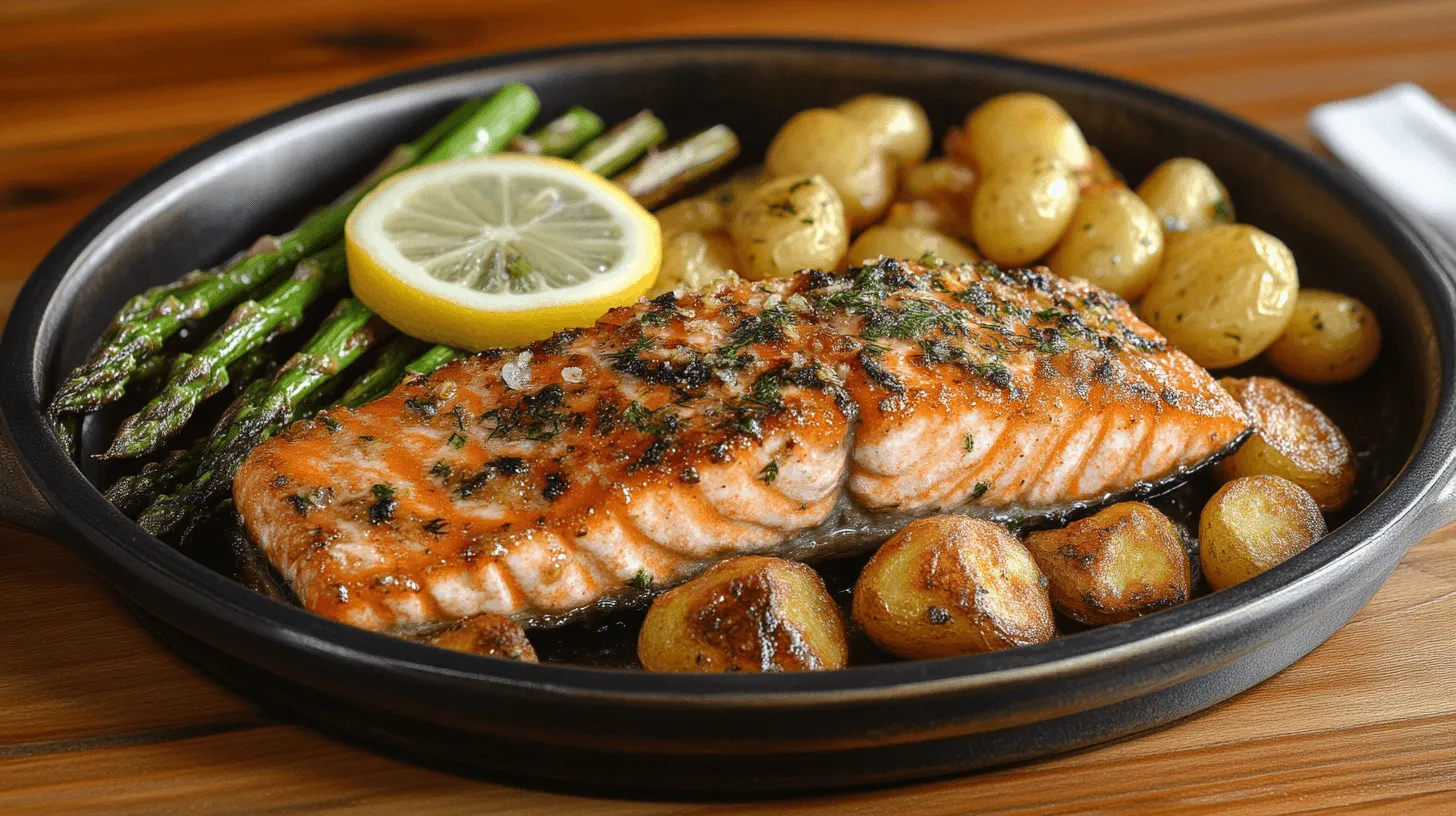King Salmon has long been celebrated for its rich, buttery flavor and tender texture, making it a favorite among seafood enthusiasts and casual cooks alike. In this King Salmon Recipe Guaranteed to Be Mouthwatering Bliss, you’ll discover a simple yet rewarding approach that combines wholesome ingredients with easy preparation techniques. Imagine the satisfaction of serving a fillet so flavorful that it rivals your favorite restaurant meal—right in the comfort of your own kitchen.
Many years ago, I attended a small family gathering where the highlight of the evening was a perfectly seared piece of king salmon. The aroma captivated everyone instantly, and the host revealed that the secret was using fresh, high-quality fish paired with vibrant, natural seasonings. Inspired by that memory, this recipe focuses on celebrating the salmon’s natural richness while ensuring that even beginner cooks can achieve restaurant-quality results. Along with its luxurious taste, king salmon offers a variety of health benefits—think lean protein and beneficial omega-3 fatty acids—which makes enjoying this dish feel like an indulgence and an investment in your well-being. Get ready to take your salmon dinners to a whole new level of delightful satisfaction!
Key Benefits
1. Superior Flavor
One of the biggest draws of king salmon is its naturally buttery taste, which pairs beautifully with a range of herbs, citrus notes, and spices. By focusing on fresh ingredients and minimal seasonings, this recipe allows the salmon’s rich, distinctive essence to shine through.
2. High Nutritional Value
Packed with beneficial omega-3 fatty acids, high-quality protein, and essential vitamins, king salmon offers a health boost in every bite. Incorporating seafood dishes like this into your routine is a delicious way to support a balanced, nutrient-rich diet.
3. Versatile Cooking Methods
Whether you prefer baking, grilling, or pan-searing, this recipe can adapt to your comfort level in the kitchen. Choose your favorite technique and achieve excellent results every time—no complicated steps required!
4. Stress-Free Preparation
Even if you’re new to cooking fish, you’ll find it surprisingly straightforward to handle. A few easy-to-source ingredients, a bit of marinating (if desired), and you’re ready to create a mouthwatering meal that looks as good as it tastes.
5. Diet-Friendly
Because this recipe avoids pork, alcohol, and other less accessible items, it suits a variety of dietary preferences. If you’re looking to impress guests or simply treat yourself to a satisfying dinner, rest assured that this dish keeps things flavorful without compromising on health or ethics.
Ingredients
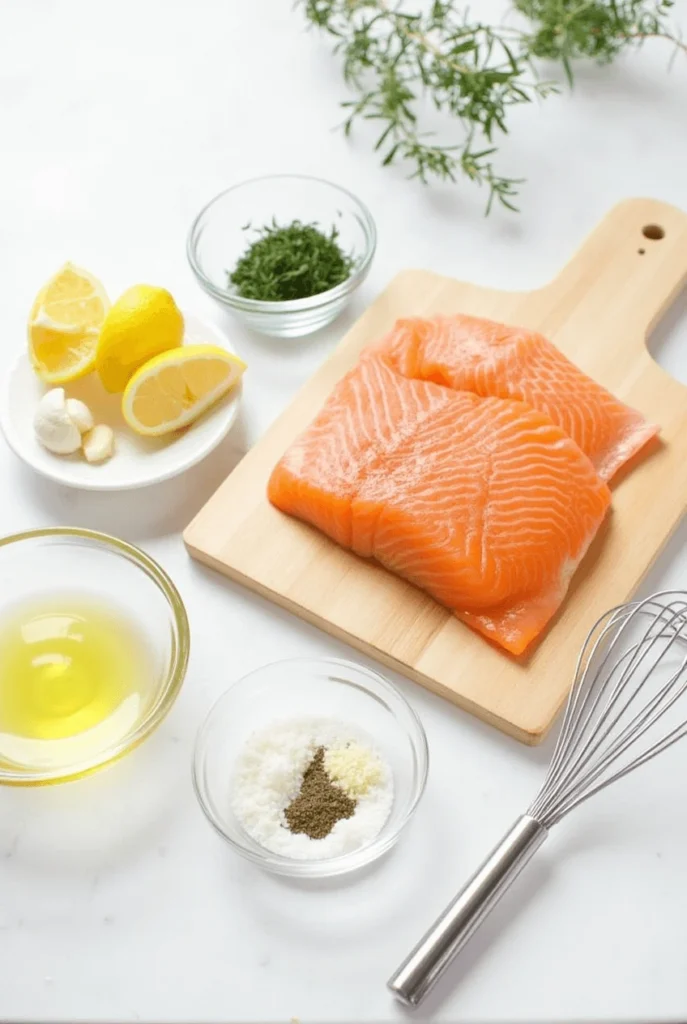
- King Salmon Fillet (1–2 pounds)
- Look for fresh, high-quality salmon with a bright color and firm texture.
- Opt for wild-caught if possible, as it often delivers a richer flavor.
- Olive Oil (2 tablespoons)
- Extra virgin olive oil adds a hint of fruitiness without overpowering the natural taste of the fish.
- You can substitute with avocado oil for a neutral flavor.
- Fresh Lemon Juice (2 tablespoons)
- A citrusy boost helps cut through the buttery richness of king salmon.
- Lime juice or even orange juice can work if you enjoy a sweeter tang.
- Garlic (2 cloves, minced)
- Provides a savory depth that pairs wonderfully with lemon and herbs.
- Herbs and Spices
- A pinch of salt, pepper, and optional dried dill enhance the overall balance.
- Feel free to experiment with paprika or chili flakes for a spicy twist.
Instructions
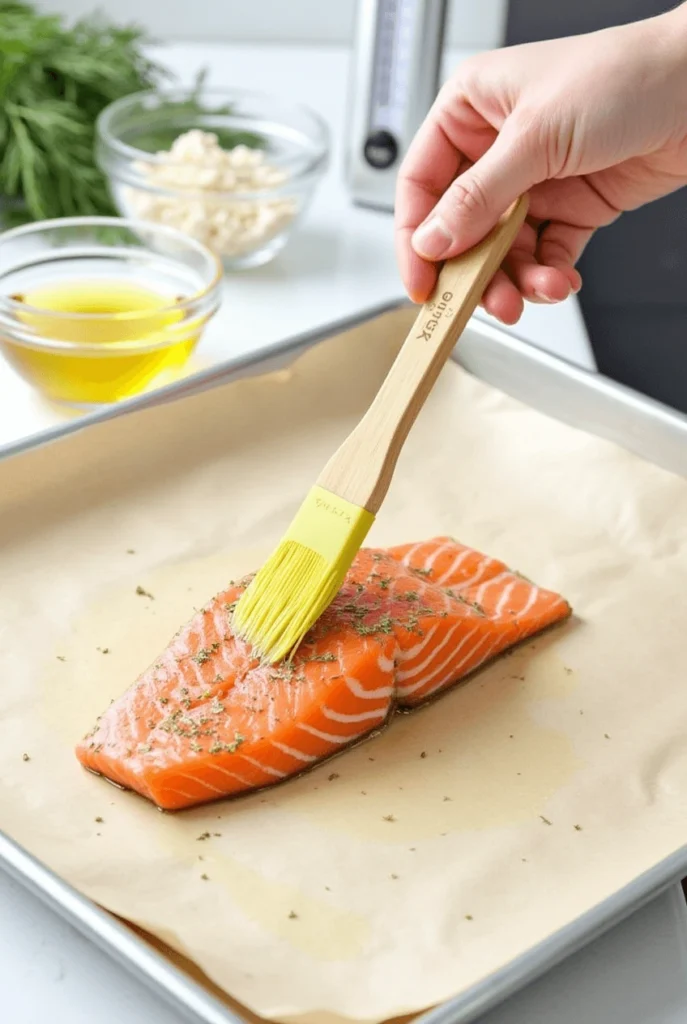
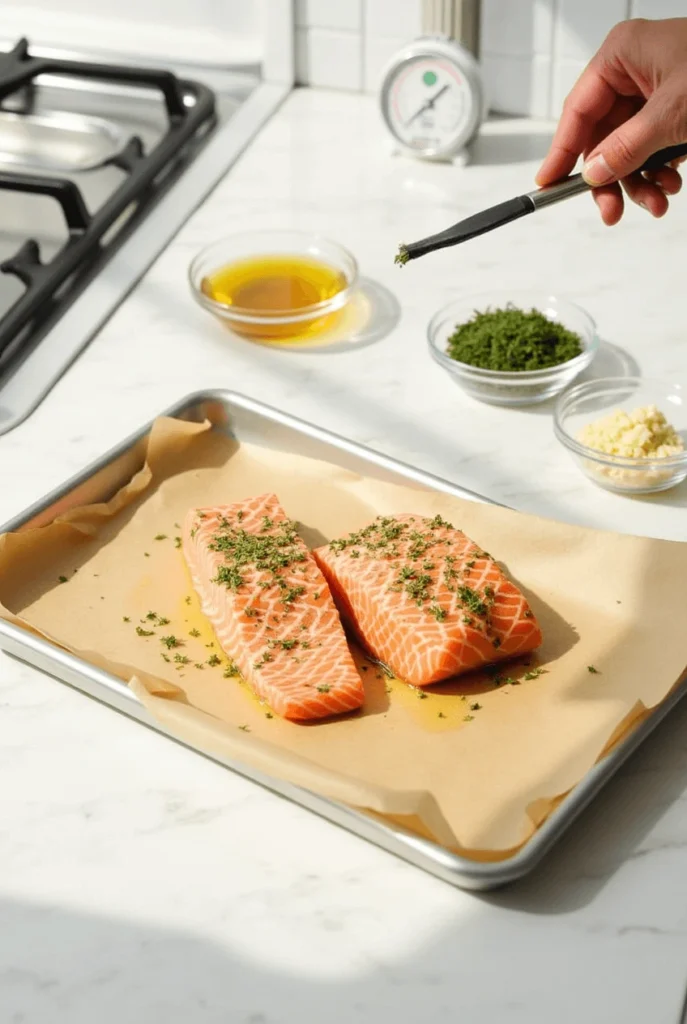
- Gather Your Tools
Before starting, make sure you have the essentials on hand: a baking dish or grill, a sharp knife, paper towels, and a small mixing bowl. Having everything ready will help you move smoothly through each step. - Prep the Salmon
- Rinse the king salmon fillet under cold water and pat it dry with paper towels. This removes any lingering debris and helps the seasoning stick better.
- If you’re using a fillet with the skin on, keep in mind that the skin can help lock in moisture during cooking.
- Mix the Marinade
- In a small bowl, combine the olive oil, fresh lemon juice, and minced garlic. Give it a gentle stir until everything is well incorporated.
- If you’re adding herbs or spices like dill, paprika, or chili flakes, whisk them in now for a more uniform flavor.
- Season the Fillet
- Lay the salmon on a flat surface, then spoon or brush the marinade generously over the top. Turn the fillet over if you’d like both sides coated.
- Sprinkle salt and pepper to taste, adjusting the amounts to your preference. For an extra zest, you can top it off with a little citrus zest or fresh herbs.
- Choose Your Cooking Method
- Oven-Baked: Preheat your oven to 400°F (200°C). Place the salmon on a parchment-lined baking sheet and cook for approximately 12 to 15 minutes, depending on thickness. You’ll know it’s done when the flesh flakes easily.
- Pan-Searing: Heat a tablespoon of oil in a nonstick skillet over medium-high heat. Carefully place the salmon in the pan, skin-side down if applicable, and cook for about 4 to 5 minutes per side.
- Grilling: Preheat your grill to medium-high. Lightly oil the grates and lay the fillet on top. Grill for 4 to 6 minutes on each side, depending on your desired level of doneness.
- Rest and Serve
- Let the salmon rest for a minute or two before slicing or plating to help the juices redistribute.
- Serve with your favorite side dishes—think roasted veggies, crisp salads, or a hearty grain like brown rice.
- Enjoy your perfectly cooked king salmon, and feel free to garnish with extra lemon wedges for a final burst of flavor!
Pro Tips and Variations
Pro Tips
- Pat It Dry
Before seasoning, gently pat the salmon fillet with paper towels. This helps the flavors cling better and reduces excess moisture when cooking. - Monitor Internal Temperature
Aim for an internal temperature of around 140°F (60°C) for moist, flaky fish. Use a kitchen thermometer to avoid overcooking and drying out your king salmon. - Marinade Magic
If you have extra time, let your salmon rest in its marinade for about 20–30 minutes. This short wait infuses deeper layers of flavor without overpowering its natural taste. - Skin-On Benefits
Cooking with the skin on helps retain moisture and creates a protective barrier against sticking or burning. You can remove the skin just before serving if preferred. - Rest Period
Give your cooked salmon a minute or two to rest before slicing. This quick pause allows the juices to redistribute, resulting in tender, succulent bites.
Variations
- Herb Swaps: Try fresh thyme, rosemary, or parsley instead of dill for a unique herbal twist.
- Citrus Fusion: Experiment with lime or orange juice instead of lemon for a bright, slightly sweet tang.
- Spice It Up: Add a sprinkle of chili powder or smoked paprika for a flavorful kick without using pork-based seasonings.
- Cooking Methods: Whether you choose to bake, grill, or sear, each technique delivers a distinct texture—from crispy edges to delicate flakes.
How to Store and Reheat
Storing Leftovers
- Cool and Package
- Allow your king salmon to cool for about 10–15 minutes before transferring it to a storage container. Wrapping warm fish can trap steam and affect both texture and flavor.
- Use an airtight container or wrap the salmon tightly in food-safe plastic wrap to prevent moisture loss and protect it from absorbing other fridge odors.
- Refrigerate Promptly
- Place the container in the coldest part of your refrigerator. Properly stored salmon remains fresh for about two days, making it ideal for a quick lunch or dinner later in the week.
- If you won’t eat it right away, consider freezing the fish. Tightly sealed salmon keeps well in the freezer for up to three months.
Reheating Tips
- Oven Method
- Preheat your oven to 300°F (150°C), then heat the salmon for around 10 minutes or until warmed through. This gentle approach helps maintain the fish’s natural moisture.
- Stovetop Refresh
- Place the salmon in a nonstick pan over low heat with a splash of water or broth, and cover. Reheat for a few minutes, ensuring you don’t overcook it.
Enjoy your perfectly stored and reheated king salmon without compromising on taste or texture!
Substitutions
- Alternate Fish Varieties
- If king salmon isn’t available, coho or sockeye salmon both offer a similarly rich flavor and moist texture. For those wanting a milder taste, try using a firm white fish like cod or halibut, adjusting the cooking time to match their leaner profile.
- Different Oils
- Extra virgin olive oil provides a fruity, robust character, but you can swap it for avocado oil if you prefer a neutral taste with a higher smoke point. A small drizzle of sesame oil also works well if you’re aiming for a subtle nutty twist.
- Herbs and Spices
- Dried dill is common in salmon recipes, yet swapping in fresh thyme, basil, or rosemary can easily change up the flavor without compromising quality. For a spicier kick, add a pinch of chili powder or a few red pepper flakes.
- Citrus Alternatives
- Lemon juice brightens up the dish, though lime juice offers a tangier accent, and orange juice delivers a sweeter citrus note.
Serving Suggestions
Light Sides
- Fresh Salads: Pair your king salmon with a crisp green salad tossed in a simple vinaigrette. The vibrant, crunchy textures highlight the fish’s naturally rich flavor without overwhelming it.
- Steamed Vegetables: Lightly seasoned broccoli, zucchini, or asparagus offer a nutrient-packed complement. Try adding a drizzle of olive oil and a sprinkle of herbs for extra taste.
Hearty Accompaniments
- Whole Grains: Brown rice, quinoa, or farro make filling additions to your salmon dinner. Their nutty undertones work beautifully with the savory, buttery notes of the fish.
- Roasted Roots: Think sweet potatoes, carrots, or beets for a sweet and earthy contrast. The roasting process caramelizes these vegetables, balancing out the richness of king salmon.
Toppings and Garnishes
- Citrus Twist: Add a few lemon or lime wedges on the side for those who crave an extra burst of zing.
- Herbal Highlights: Sprinkle fresh dill, parsley, or basil on top to elevate both the aroma and presentation.
Feel free to mix and match these ideas to craft a memorable, crowd-pleasing meal!
Conclusion
Wrap-Up
By now, you’ve discovered just how easy it can be to prepare a king salmon recipe that’s both satisfying and nutritious. From choosing fresh fillets to seasoning with vibrant herbs, each step enhances the fish’s natural richness without compromising on dietary restrictions.
Final Thoughts
- Experiment with Confidence: Don’t hesitate to switch up the sides or try new flavor combinations.
- Savor Every Bite: Take a moment to appreciate the tender texture and buttery taste that make this recipe a standout meal.
- Share the Joy: Because it’s free of pork and alcohol, this dish is ideal for diverse gatherings.
Enjoy the journey, and celebrate your success in the kitchen!
—————————–
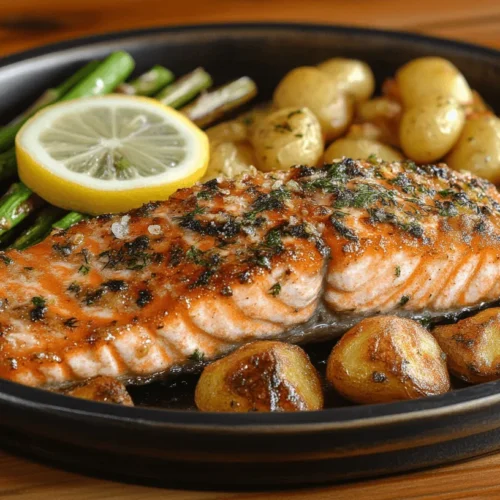
King Salmon
Ingredients
King Salmon Fillet (1–2 pounds)
- Look for fresh high-quality salmon with a bright color and firm texture.
- Opt for wild-caught if possible as it often delivers a richer flavor.
Olive Oil (2 tablespoons)
- Extra virgin olive oil adds a hint of fruitiness without overpowering the natural taste of the fish.
- You can substitute with avocado oil for a neutral flavor.
Fresh Lemon Juice (2 tablespoons)
- A citrusy boost helps cut through the buttery richness of king salmon.
- Lime juice or even orange juice can work if you enjoy a sweeter tang.
Garlic (2 cloves, minced)
- Provides a savory depth that pairs wonderfully with lemon and herbs.
Herbs and Spices
- A pinch of salt pepper, and optional dried dill enhance the overall balance.
- Feel free to experiment with paprika or chili flakes for a spicy twist.
Instructions
Gather Your Tools
- Before starting, make sure you have the essentials on hand: a baking dish or grill, a sharp knife, paper towels, and a small mixing bowl. Having everything ready will help you move smoothly through each step.
Prep the Salmon
- Rinse the king salmon fillet under cold water and pat it dry with paper towels. This removes any lingering debris and helps the seasoning stick better.
- If you’re using a fillet with the skin on, keep in mind that the skin can help lock in moisture during cooking.
Mix the Marinade
- In a small bowl, combine the olive oil, fresh lemon juice, and minced garlic. Give it a gentle stir until everything is well incorporated.
- If you’re adding herbs or spices like dill, paprika, or chili flakes, whisk them in now for a more uniform flavor.
Season the Fillet
- Lay the salmon on a flat surface, then spoon or brush the marinade generously over the top. Turn the fillet over if you’d like both sides coated.
- Sprinkle salt and pepper to taste, adjusting the amounts to your preference. For an extra zest, you can top it off with a little citrus zest or fresh herbs.
Choose Your Cooking Method
- Oven-Baked: Preheat your oven to 400°F (200°C). Place the salmon on a parchment-lined baking sheet and cook for approximately 12 to 15 minutes, depending on thickness. You’ll know it’s done when the flesh flakes easily.
- Pan-Searing: Heat a tablespoon of oil in a nonstick skillet over medium-high heat. Carefully place the salmon in the pan, skin-side down if applicable, and cook for about 4 to 5 minutes per side.
- Grilling: Preheat your grill to medium-high. Lightly oil the grates and lay the fillet on top. Grill for 4 to 6 minutes on each side, depending on your desired level of doneness.
Rest and Serve
- Let the salmon rest for a minute or two before slicing or plating to help the juices redistribute.
- Serve with your favorite side dishes—think roasted veggies, crisp salads, or a hearty grain like brown rice.
- Enjoy your perfectly cooked king salmon, and feel free to garnish with extra lemon wedges for a final burst of flavor!
Notes
- Calories: ~300
- Total Fat: ~15g (primarily heart-healthy omega-3 fats)
- Protein: ~25g
- Carbohydrates: ~2g
- Other Nutrients: Contains B vitamins, selenium, and potassium
FAQs
1. Can I cook the salmon straight from frozen?
It’s usually best to thaw salmon overnight in the refrigerator for more even cooking. If you must cook from frozen, add a few extra minutes and watch closely to avoid overcooking.
2. How do I know when my king salmon is fully cooked?
Aim for an internal temperature of around 140°F (60°C). The flesh should flake easily with a fork and have an opaque appearance. A food thermometer helps ensure consistent results.
3. What if I don’t have fresh herbs available?
Dried herbs work just fine and can be substituted in a 1:3 ratio (one teaspoon of dried for every tablespoon of fresh). Feel free to mix and match flavors like dill, thyme, or rosemary.
4. Should I remove the skin before cooking?
Leaving the skin on helps retain moisture and makes flipping easier. You can peel it off just before serving if you prefer. For a crispy texture, cook skin-side down first.
5. Can I use a different type of fish with this recipe?
Absolutely! Coho or sockeye salmon are great alternatives with a similarly rich taste, while cod or halibut offer a milder flavor. Adjust cooking times as needed.
6. How long will leftovers last in the fridge?
Properly stored in an airtight container, your leftover salmon should stay fresh for up to two days. Reheat gently on the stovetop or in a low-temperature oven to avoid drying it out.
Nutritional Information
When you savor this king salmon recipe, you’re not just treating your taste buds—you’re also nurturing your body. Here’s a quick overview of what you can expect in a roughly 4-ounce serving:
- Calories: Approximately 300 calories, depending on the exact size of the fillet and any added ingredients.
- Protein: Around 25 grams of high-quality protein, perfect for building and maintaining muscle.
- Fats: Roughly 15 grams, primarily from heart-healthy omega-3 fatty acids found naturally in salmon.
- Carbohydrates: Minimal, typically under 2 grams—helpful if you’re watching your carb intake.
- Vitamins and Minerals: A good dose of B vitamins, selenium, and potassium, all contributing to overall well-being.
These values can vary, but they highlight salmon’s reputation as a delicious, nutrient-rich choice—without any pork or alcohol in the mix!

